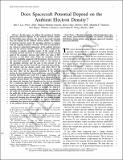Does Spacecraft Potential Depend on the Ambient Electron Density?
Author(s)
Lai, Shu T; Martinez-Sanchez, Manuel; Cahoy, Kerri; Thomsen, Michelle F; Shprits, Yuri; Lohmeyer, Whitney; Wong, Frankie K; ... Show more Show less
DownloadAccepted version (3.146Mb)
Terms of use
Metadata
Show full item recordAbstract
© 2017 IEEE. In this paper, we address the question of whether spacecraft potential depends on the ambient electron density. In Maxwellian space plasmas, the onset of spacecraft charging does not depend on the ambient electron density. The balance of electron currents causes the incoming electrons to balance with the outgoing secondary electrons. The onset is controlled by the critical or anticritical temperature of the ambient electrons, but not the electron density. Above the critical temperature, charging to negative potential occurs. If the energy of the incoming electrons increases to well beyond the second crossing point of the secondary electron yield (SEY), the value of SEY decreases to well below unity. When the secondary electron current is negligible compared with the primary electron current, the spacecraft potential is governed solely by the balance of the incoming electrons and the sum of the currents of the repelled electrons and the attracted ions. In neutral space plasma, the electron and ion charges cancel each other. But if the space plasma deviates from being neutral, then the densities can have effect on the spacecraft potential. If the ambient plasma deviates significantly from equilibrium, a non-Maxwellian electron distribution may result. For a kappa distribution, one can show that the spacecraft charging level is independent of the ambient electron density. For a double Maxwellian distribution, the spacecraft charging level depends on the electron densities. For a conducting spacecraft charging in sunlight, the charging level is low and positive. It also depends on the ambient electron density. For a dielectric spacecraft in sunlight, the high-level negative-voltage charging on the shadowed side may extend to the sunlit side and block the photoelectrons trying to escape from the sunlit side. In this case, the charging level does not depend on ambient electron density. Using coordinated environmental and spacecraft charging data obtained from the Los Alamos National Laboratory geosynchronous satellites, we showed some results confirming that spacecraft potential is indeed often independent of the ambient electron density.
Date issued
2017Department
Massachusetts Institute of Technology. Space Propulsion Laboratory; Space Telecommunications Astronomy and Radiation (STAR) LabJournal
IEEE Transactions on Plasma Science
Publisher
Institute of Electrical and Electronics Engineers (IEEE)